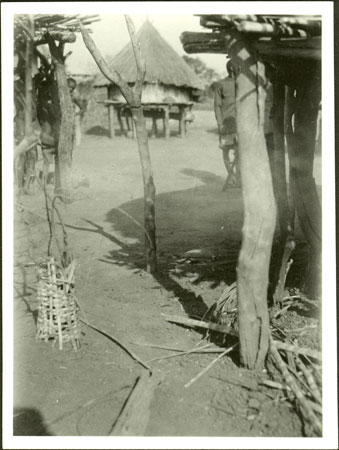Beli rain-making shrine

103 x 75 mm | Print gelatin silver
Condition:
fading/silver sulphide staining [EE 1989]
Date of Print:
Unknown
Previous PRM Number:
EP.B.25
Previous Other Number:
63 2 [frame 9]
Accession Number:
1998.343.24.2
Description:
A notched forked branch shrine (called heri) set within a homestead, used in rain-making ritual by Totio the Beli rain-maker.
At the base of the shrine are two metal spear-heads (called me ngeri "spears of the chief") and some pot sherds, under which is kept a rain-stone (a polished stone axe-head about 1.5 inches long), said to be the only one in Beli country.
Such stones are associated with thunder, hence their Beli name pamu or nyolimu liri - the teeth or hammer of thunder.
Evans-Pritchard visited Totio's homestead on April 4th during the dry season, and was given a demonstration of the efficacy of special horns blown by the rain-maker, after which rain unexpectedly fell.
Photographer:
Edward Evan Evans-Pritchard
Date of Photo:
1929 March
Region:
[Southern Sudan] Warab Tonj
Group:
Beli [Rumbek Jur]
PRM Source:
Edward Evan Evans-Pritchard
Acquired:
Donated 1966
Other Owners:
E. E. Evans-Pritchard Collection
Class:
Death , Carving , Shelter , Weapon , Pottery
Keyword:
Grave , Grave Marker , Memorial , Building Storage , Spear , Plant
Primary Documentation:
PRM Accession Records - Accession Book Entry [p.
98] 1966.27 [1 - 24] G[ift] PROFESSOR E.
E.
EVANS-PRITCHARD; INST.
OF SOCIAL ANTHROPOLOGY, 51 BANBURY RD.
OXFORD - 1966.27.19 - S.
SUDAN, DARFUNG.
VARIOUS TRIBES.
Box of negatives in envelopes, [1 - 242] & 1966.27.20 - Box of prints of these negatives [refers to object 1966.27.19] [1 - 242], in envelopes.
Notes on print/mount ms pencil - "63/2"
Notes on card mount m/s pencil - "?fading SSS overall 8.89"
Notes on print/mount ms pencil - "63/2"
Notes on card mount m/s pencil - "?fading SSS overall 8.89"
Other Information:
In "The Bongo" (Sudan Notes and Records Vol.XII Part I 1929 page 37) E.
E.
Evans-Pritchard notes that 'the Bongo graves are surrounded by carved wooden figures of men and carved posts tallying the number of the larger animals killed by the deceased during his lifetime.
The different animals killed may be counted by adding up the different kinds of notches and by the shape of the forked head of the posts.' On page 39 he notes that 'when they have performed this [arrow] ceremony, those who have been shooting the arrows come and place hoes, spears, knives, etc.
on the ground, and these are gathered by the master of the feast, who gives them later to one or more of his sister's sons, retaining only a few small things, such as knives for his sisters, and a single spear for himself, which he walks about with.
Pots of beer are then distributed to the people who have paid spears, hoes, knives etc.
in accordance with their contribution.' [Chris Morton 15/1/2004]
Recorder:
Christopher Morton 15/1/2004 [Southern Sudan Project]

